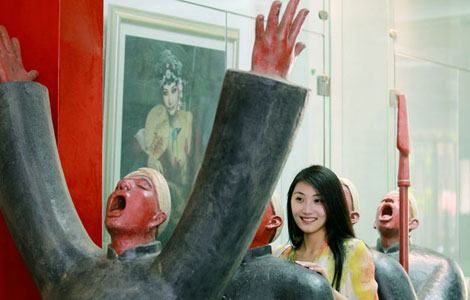Going for gloves off in defense
Updated: 2013-09-27 09:42
By Cai Hong (China Daily)
|
|||||||||||
Japan looks to expand military role while main allies cut forces
Building a stronger bond between the United States and Japan is how the incoming US ambassador to Japan, Caroline Kennedy, described her mission in Tokyo.
Coasting through a Senate confirmation hearing in Washington on Sept 19, the former first daughter said the post-war alliance between the two countries had a "global reach". She vowed to "further strengthen this critical partnership at a vital moment in its history".
Japan's expectations of Kennedy were made obvious by the rare presence of Kenichiro Sasae, Japanese ambassador to the United States, at her confirmation hearing.
The larger military role the US expects Japan to play in the world, and the ambition Prime Minister Shinzo Abe harbors, are driving the country to change the defense-only nature of its armed forces.
Abe wants to broaden the role of the Self-Defense Forces by changing the interpretation of the pacifist constitution. Specifically, Abe wants to allow the SDF to exercise the "right of collective self-defense", or the right to aid or be aided by its allies such as the United States in the event of attack, even if Japan itself is not at risk.
Abe's predecessors have maintained for decades that Japan's constitution does not grant such a right, given the war-renouncing Article 9, which bans the use of force as a means of settling international disputes.
His government's advisory panel of security experts resumed discussions on Sept 17 and 18 after a seven-month hiatus. They are expected to lay the groundwork for a review of the government's current interpretation of the constitution.
Japan and the US are working on how to revise their defense cooperation guidelines, which define the roles of Japan's SDF and the US military. Japan is home to the US Navy's 7th Fleet and 50,000 US troops.
Japanese Defense Minister Itsunori Onodera indicated on Sept 3 that revised guidelines could define Japan's capacity to mount attacks on the military bases of hostile nations.
Japan's intention to change its defense-only posture has been welcomed, or, to be more exact, prompted by the US.
During his visit to Tokyo in May, former US deputy secretary of state Richard Armitage supported Abe on lifting Japan's ban on the right of collective self-defense. He said the prohibition is an "impediment" to US-Japan cooperation.

The US drafted Japan's pacifist constitution, which forbids the maintenance of military forces or the use of those forces to settle international disputes. But during the Cold War, Japan was poised to fight alongside US forces whenever and wherever necessary, with the US continually requesting military assistance from Japan.
Though the US came up with the "pivot to Asia" policy, its financial predicament has forced it to cut defense spending.
In their August assessment report, four Washington-based think tanks - American Enterprise Institute, Center for a New American Security, Center for Strategic and International Studies, and Center for Strategic and Budgetary Assessment - assumed that the US will have to reduce its fleet by two to four aircraft carriers, seven to nine cruisers and four to 14 destroyers.
The think tanks pinned their hopes on US allies filling the gaps created by the shrinking US military presence. In the Atlantic, the Canadian navy has already joined US naval task forces.
US security experts have also welcomed Japan's plan to increase its submarine fleet from 16 to 22.
In a report last year titled "US-Japan Alliance: Anchoring Stability in Asia", a US bipartisan study group co-chaired by Armitage and political scientist Joseph Nye said Japan has several untapped sources of power and influence that could allow it to remain a "tier-one" global player.
The report recommended that the two allies require more robust, shared and interoperable intelligence, surveillance and reconnaissance capabilities and operations that extend well beyond Japanese territory.
"It would be a responsible authorization on the part of Japan to allow US forces and Japan's SDF to respond in full cooperation throughout the security spectrum of peacetime, tension, crisis and war," the report said.
In January, Japan's cabinet decided to allocate more than $1 billion in additional defense spending this year. This made Japan the only major US ally not to make defense cuts this year.
The renewed debate in Tokyo on Japan's right of collective self-defense has raised questions on whether the nation will send its troops to fight for its allies on the other side of the globe.
Abe said earlier that Japan needs to take on a greater security role and pursue what he describes as "an active pacifism" to ensure global peace and stability.
Japan and the US announced that a formal agreement on the revision of the current Japan-US defense cooperation guidelines will be made in October. Japan's Defense Minister Onodera and US Defense Secretary Chuck Hagel, along with Japanese Foreign Minister Fumio Kishida and US Secretary of State John Kerry, plan to hold the meeting in Tokyo on Oct 3.
The issue of Japan's right to collective self-defense, or to defend an ally under armed attack, is on the table.
This would seem to be the time for Japan to lift the ban on the right to collective self-defense and make its SDF more visible in the international theater.
Though an advocate of Japan's right to collective self-defense, the US Assistant Secretary of State for East Asian and Pacific Affairs, Daniel Russell, suggested that Japan specify its motives to dispel neighboring countries' suspicions and fears. The US has to take the wariness of its other East Asian ally South Korea and that of Southeast East nations into account.
Japan's military build-up, albeit supporting the US, causes tension in the region.
The author is China Daily's Tokyo bureau chief. Contact the writer at caihong@chinadaily.com.cn.
(China Daily European Weekly 09/27/2013 page13)
Today's Top News
Website launched to assist expat professionals
50 foreign experts honored with Friendship Awards
Up, up, Huawei finds new friends in Europe nations
Visible face of CIC investment
Shanghai opens free trade zone
Academic warns Obama on Pacific policy
Little-known now, but a big future
NSA mapping social networks of US citizens
Hot Topics
Lunar probe , China growth forecasts, Emission rules get tougher, China seen through 'colored lens', International board,
Editor's Picks

|

|

|

|

|

|





